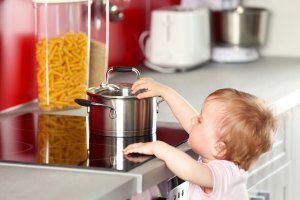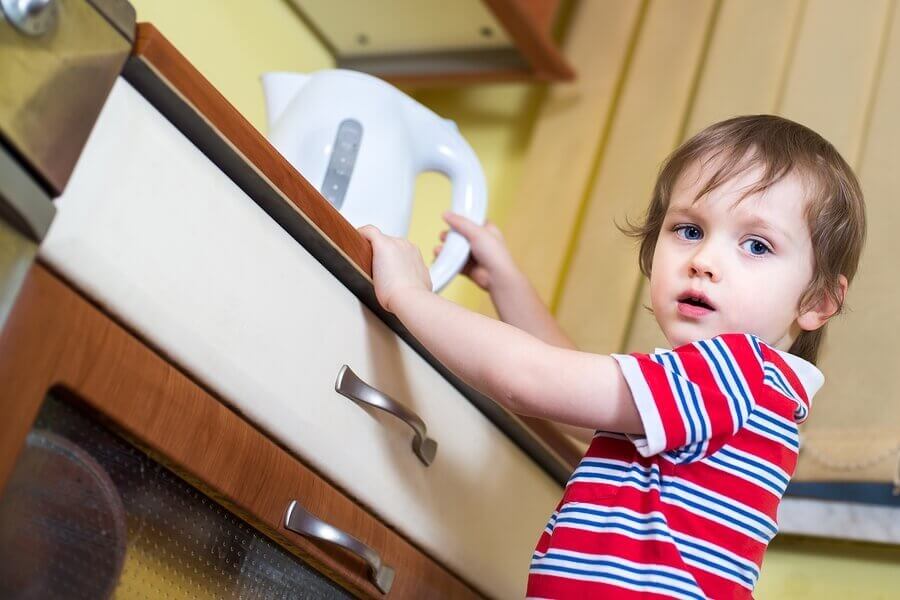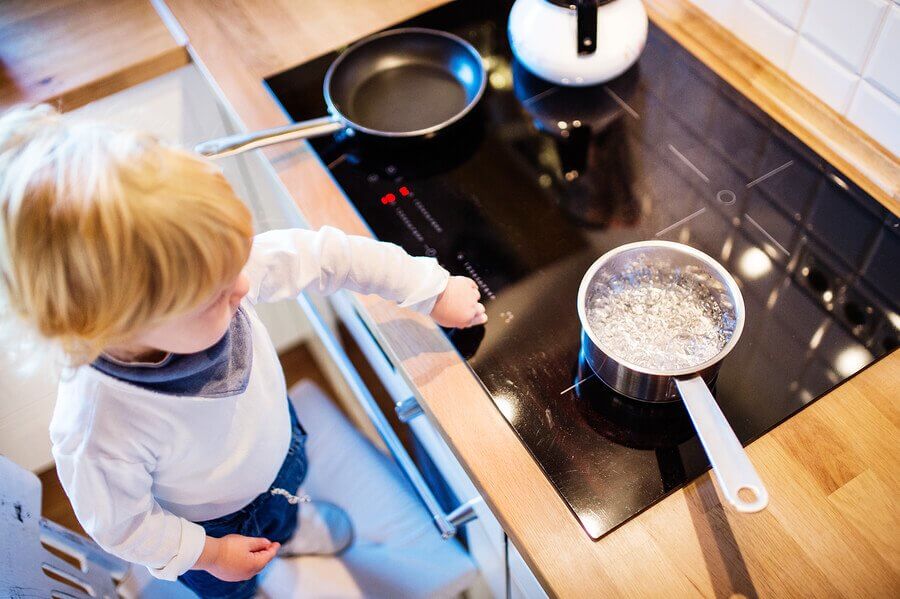What to Do if Your Child Burns Himself in the Kitchen


Reviewed and approved by the psychologist María Alejandra Castro Arbeláez
What do I do if my child burns himself in the kitchen? Should I perform first aid or call 9-1-1 immediately?
Many of these concerns from parents are completely valid. They also show that many families don’t know how to offer first aid for small and delicate accidents like burns.
Being able to identify the severity of burns, the sequence of actions, and what kind of care your child needs could guarantee the best recovery.
What to do if your child burns himself in the kitchen
Children are especially prone to accidents and burns in the kitchen for two reasons.
First, they try to imitate everything adults do. This leads them to want to do things, like cook. Second, kids are interested in the stove because the lights and smells spark their curiosity and attention.
Of course, your main focus should be prevention. Prevent kids from entering the kitchen without adult supervision. Also, don’t keep dangerous things within reach, like kitchen knives or fire on the stove.
However, something may still happen. What do you do if an accident has inevitably occurred? What are the steps you should take to resolve the situation?

Identify the severity of the burn
To be able to treat an accidental kitchen burn, you need to figure out how serious the burn is. Pay attention to the steps below:
- Remove the child from the kitchen as soon as he burns himself.
- Expose the burned skin to fresh water at about 68ºF. This prevents the heat from penetrating deeper layers of the skin. Also, it prevents it from becoming a third degree burn.
- If you notice that it’s a third degree burn, go to the hospital immediately. If it’s only a first degree burn and is small, you can treat your child from home.
Types of burns and their characteristics
There are three types of burns:
1. First degree burns
They’re also called minor burns, and they only affect the outer layer of the skin. Their symptoms are: reddening of the skin, moderate inflammation, burning and pain in the area.
2. Second degree burns
They’re partial thickness burns, and they penetrate the lower and outer layers of the skin. They can be about 2-2.5 inches long on the surface.
Therefore, the severity also depends on how big it is. Its symptoms are: redness, burning, pain, and inflammation with blisters.
“Of course, your main focus should be prevention. Prevent kids from entering the kitchen without adult supervision.”
3. Third degree burns
These penetrate and damage all layers of the skin. In addition, they cause the skin to turn black or white, depending on the cause. They also cause intense pain, which is accompanied by numbness of the affected area.
It’s important to emphasize that children may have more than one type of burn on their skin. Therefore, if you notice that the burn covers a large area or appears to be of the third degree, it’s best to go to the emergency room or to a specialist.
This way, with the help of a professional, you can guarantee that your child’s skin will completely recover. You can also help prevent scarring.

Home treatments for first degree burns
If you’ve identified that your child’s burn is first degree and is small, we recommend that you do the following:
- Cool the affected area with fresh water around 68-70ºF for at least 10 minutes.
- Give him an ibuprofen pill to relieve pain.
- Once the area is clean, apply a hypoallergenic healing cream or aloe vera at least twice a day.
Finally, you should know that you should never rub ice on the burn or creams high in fat. These will actually worsen the irritation and keep it from healing properly.
What do I do if my child burns himself in the kitchen? Should I perform first aid or call 9-1-1 immediately?
Many of these concerns from parents are completely valid. They also show that many families don’t know how to offer first aid for small and delicate accidents like burns.
Being able to identify the severity of burns, the sequence of actions, and what kind of care your child needs could guarantee the best recovery.
What to do if your child burns himself in the kitchen
Children are especially prone to accidents and burns in the kitchen for two reasons.
First, they try to imitate everything adults do. This leads them to want to do things, like cook. Second, kids are interested in the stove because the lights and smells spark their curiosity and attention.
Of course, your main focus should be prevention. Prevent kids from entering the kitchen without adult supervision. Also, don’t keep dangerous things within reach, like kitchen knives or fire on the stove.
However, something may still happen. What do you do if an accident has inevitably occurred? What are the steps you should take to resolve the situation?

Identify the severity of the burn
To be able to treat an accidental kitchen burn, you need to figure out how serious the burn is. Pay attention to the steps below:
- Remove the child from the kitchen as soon as he burns himself.
- Expose the burned skin to fresh water at about 68ºF. This prevents the heat from penetrating deeper layers of the skin. Also, it prevents it from becoming a third degree burn.
- If you notice that it’s a third degree burn, go to the hospital immediately. If it’s only a first degree burn and is small, you can treat your child from home.
Types of burns and their characteristics
There are three types of burns:
1. First degree burns
They’re also called minor burns, and they only affect the outer layer of the skin. Their symptoms are: reddening of the skin, moderate inflammation, burning and pain in the area.
2. Second degree burns
They’re partial thickness burns, and they penetrate the lower and outer layers of the skin. They can be about 2-2.5 inches long on the surface.
Therefore, the severity also depends on how big it is. Its symptoms are: redness, burning, pain, and inflammation with blisters.
“Of course, your main focus should be prevention. Prevent kids from entering the kitchen without adult supervision.”
3. Third degree burns
These penetrate and damage all layers of the skin. In addition, they cause the skin to turn black or white, depending on the cause. They also cause intense pain, which is accompanied by numbness of the affected area.
It’s important to emphasize that children may have more than one type of burn on their skin. Therefore, if you notice that the burn covers a large area or appears to be of the third degree, it’s best to go to the emergency room or to a specialist.
This way, with the help of a professional, you can guarantee that your child’s skin will completely recover. You can also help prevent scarring.

Home treatments for first degree burns
If you’ve identified that your child’s burn is first degree and is small, we recommend that you do the following:
- Cool the affected area with fresh water around 68-70ºF for at least 10 minutes.
- Give him an ibuprofen pill to relieve pain.
- Once the area is clean, apply a hypoallergenic healing cream or aloe vera at least twice a day.
Finally, you should know that you should never rub ice on the burn or creams high in fat. These will actually worsen the irritation and keep it from healing properly.
All cited sources were thoroughly reviewed by our team to ensure their quality, reliability, currency, and validity. The bibliography of this article was considered reliable and of academic or scientific accuracy.
- EMILLIA C. O. LLOYD et al. (2012). “Outpatient Burns: Prevention and Care”, American Family Physician. https://www.aafp.org/afp/2012/0101/p25.html
- Mayo Clinic Staff. (2018). Burns: fist aid. https://www.mayoclinic.org/first-aid/first-aid-burns/basics/art-20056649
- Ana Peñalba Citores, Rafael Marañón Pardillo. (n.d.). “Tratamiento de las quemaduras en urgencias”, Protocolos diagnóstico-terapéuticos de Urgencias Pediátricas SEUP-AEP, Sección de Urgencias Pediátricas. Hospital Universitario Gregorio Marañón. Madrid. https://www.aeped.es/sites/default/files/documentos/tratamiento_de_las_quemaduras_en_urgencias.pdf
- DR. DAVID FERJ B. (2009). “QUEMADURAS EN EDAD PEDIÁTRICA”, REV. MED. CLIN. CONDES – 2009; 20(6) 849 – 859.
This text is provided for informational purposes only and does not replace consultation with a professional. If in doubt, consult your specialist.








